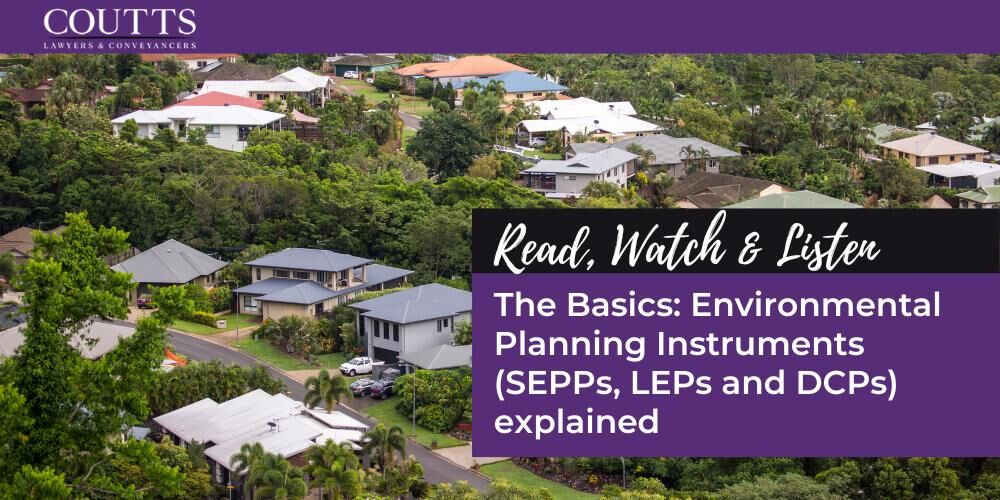KEY TAKE-OUTS:
Helping you to understand the foundations that underpin the environment and planning law space means you are ready for your next move in property development. Here we will be answering the following critical questions about Environmental Planning Instruments:
- What are the Environmental Planning Instruments?
- What are the State Environmental Planning Policies (SEPPs)?
- What is the purpose of a Local Environmental Plan (LEP)?
- What is a Development Control Plan (DCP) and how is it different to the LEP?
What are Environmental Planning Instruments (EPIs)?
Environmental Planning Instruments are the legislative documents that apply to property development in NSW.
The different EPIs are:
- State Environmental Planning Policies; and
- Local Environmental Plans.
Development Control Plans are slightly different in that they are developed by each Council but are more advisory.
What are the State Environmental Planning Policies (SEPPs)?
There are 12 SEPPs, which each focus on a separate planning principle being:
- Exempt and Complying Development
- Biodiversity and Conservation
- Industry and Employment
- Resilience and Hazards
- Resources and Energy
- Transport and Infrastructure
- Planning Systems
- Precincts—Central River City
- Precincts—Eastern Harbour City
- Precincts—Regional
- Precincts—Western Parkland City, Primary Production.
SEPPs are policies prepared by the Department of Planning and Environment. Generally, they deal with land use and urban and regional development in a state-wide context. However, they may deal with specific sites with state significance or provide a legal framework for a specific planning issue. Importantly, the effect of a SEPP is that it can override an LEP and can prohibit certain types of development or can allow development in a certain zone.
A SEPP can also act as standalone planning law, having legal force, such as the SEPP for Exempt and Complying Development.
The purpose of the SEPPs is to free up the planning process and expedite development.
What is the purpose of a Local Environmental Plan (LEP)?
A Local Environmental Plan divides the Council area (or Local Government Area) into land use zones. Land use zones help to identify what types of development are allowed in each area either with or without consent or prohibited. The land use zones are broken down into the following categories:
- Rural
- Residential
- Economic
- Mixed Use
- Business
- Industrial
- Special land purposes
- Recreation
- Conservation; and
- Waterways
LEPs are developed by Councils, however, they must incorporate compulsory sections as set out by the Standard Instrument—Principal Local Environmental Plan (2006 EPI 155a)
Councils use LEPs to guide the planning decisions concerning both private and public land through zoning and development controls, these include zoning, maximum building height and floor space ratios.
What is a Development Control Plan (DCP) and how is it different to the LEP?
Like the LEP, SEPPs override Development Control Plans. The creation of a DCP is legislated under section 3.43 of the Environmental Planning and Assessment Act 1979 (the EP & A Act).
A DCP supports the LEP by providing specific and detailed development controls relating to complex aspects of design and providing guidance. These controls include minimum rates of car parking, setbacks for buildings and minimum landscaping requirements.
Compliance with a DCP is more flexible than the controls stated in an LEP as it is not a legislative instrument. Section 3.42 of the EP & A Act provides Councils flexibility in applying the controls set out in a DCP where alternative solutions can be applied to give effect to the LEP, facilitate development and the objectives of the zone as they are regulations and not a statutory requirement.
If you would like to know more about how the SEPPs, LEPs and DCPs apply and affect your property or development reach out to our Environment and Planning Law team.
For further information please don’t hesitate to contact Coutts Lawyers.
This blog is merely general and non-specific information on the subject matter and is not and should not be considered or relied on as legal advice. Coutts is not responsible for any cost, expense, loss or liability whatsoever to this blog, including all or any reliance on this blog or use or application of this blog by you.



